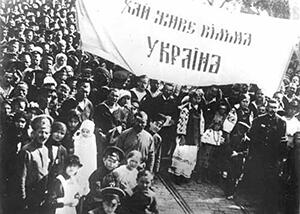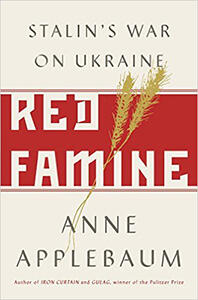 One hundred years ago, a series of upheavals in the Russian Empire ended the rule of the Tsars and ushered in a new era of communism.
One hundred years ago, a series of upheavals in the Russian Empire ended the rule of the Tsars and ushered in a new era of communism.
The Ukrainian People’s Republic, which was declared by the Central Rada in November in response to the Bolshevik coup in Petrograd, managed to resist a similar Bolshevik coup in Kyiv. Subsequently, the Central Rada proclaimed the political independence of the state in January 1918, severing its remaining ties with Bolshevik Russia.
Attacked by the communist regime in Moscow, Ukraine’s independent statehood didn’t last long, and the state was soon captured by the Bolsheviks, who proclaimed the creation of their own republic under Moscow’s control and eventually as part of the Soviet Union.
Now, a century later, Ukraine’s drive for independence and self-determination is once again facing tests. The Orange Revolution, Euromaidan, and the ongoing battle with Russia over eastern regions highlight the people’s determination to reject subjugation by Russia and embrace their own vision for Ukraine. As Serhii Plokhii writes in his book Lost Kingdom, the legacy of the 1917 events still endures: “The genie of independence was now out of the imperial bottle, and no force on earth could put it back.”
To commemorate this turning point in Ukrainian history, the Ukrainian Research Institute at Harvard University (HURI) has organized a series of events examining the revolution and its consequences. In addition to our series, a number of events at Harvard are devoted to the 1917 revolutions in the Russian Empire and beyond. The Davis Center will host several talks and a conference on the Russian Revolution (which was organized by Serhii Plokhii, among others, and includes talks on Ukraine). Those who are interested in our Ukraine in the Flames of the 1917 Revolution series may also want to seek out these events.
Film Screening & Discussion of Arsenal: Ukrainian Revolution Portrayed by a Counter-Revolutionary
Yuri Shevchuk, Lecturer, Department of Slavic Languages, Columbia University
October 18, 6:00-8:00pm, CGIS S-020
 The goal of Arsenal was to celebrate and glorify the Bolshevik occupation of Ukraine, to present it as the will of the Ukrainian proletariat and a historical inevitability. Outwardly the film fulfilled this goal, but on closer inspection, its message often undermined the legitimacy of the “revolutionary conquest” of Ukraine, by posing the question of whether the Bolshevik victory was worth the horrific and enormous suffering it caused to the people. As George Lieber aptly notes, “If the film enthusiastically endorsed the Bolshevik point of view, its subtext questioned the morality of Bolshevik revolutionary brutality.”
The goal of Arsenal was to celebrate and glorify the Bolshevik occupation of Ukraine, to present it as the will of the Ukrainian proletariat and a historical inevitability. Outwardly the film fulfilled this goal, but on closer inspection, its message often undermined the legitimacy of the “revolutionary conquest” of Ukraine, by posing the question of whether the Bolshevik victory was worth the horrific and enormous suffering it caused to the people. As George Lieber aptly notes, “If the film enthusiastically endorsed the Bolshevik point of view, its subtext questioned the morality of Bolshevik revolutionary brutality.”
Presenting in one scene a Ukrainian nationalist as spineless and paralyzed whereas his Bolshevik adversary as cold-bloodedly ruthless, Dovzhenko is disturbingly prescient of the Kremlin genocidal brutality of the Holodomor, which would be visited on Ukaine two years after the film’s release.
Read a Q&A about this film with Yuri Shevchuk here.
Holodomor Reconsidered: The Bolshevik Revolution and the Ukrainian Famine
Anne Applebaum, Journalist and Pulitzer Prize-Winning Author
October 23, 4:15-6:00pm, CGIS S-020
 Pulitzer Prize-winning author Anne Applebaum discusses the revelations of her latest book, Red Famine: Stalin’s War on Ukraine. While the Holodomor did not take place for well over a decade after the events of 1917, Applebaum argues that the threat of Ukrainian nationalism motivated Stalin to “[make] use of the catastrophe [of collectivization failures] to rid itself of a political problem.”
Pulitzer Prize-winning author Anne Applebaum discusses the revelations of her latest book, Red Famine: Stalin’s War on Ukraine. While the Holodomor did not take place for well over a decade after the events of 1917, Applebaum argues that the threat of Ukrainian nationalism motivated Stalin to “[make] use of the catastrophe [of collectivization failures] to rid itself of a political problem.”
Applebaum writes: “Neither crop failure nor bad weather caused the famine in Ukraine. Although the chaos of collectivization helped create the conditions that led to famine, the high numbers of deaths in Ukraine between 1932 and 1934, and especially the spike in the spring of 1933, were not caused directly by collectivization either. Starvation was the result, rather, of the forcible removal of food from people’s homes; the roadblocks that prevented peasants from seeking work or food; the harsh rules of the blacklists imposed on farms and villages; the restrictions on barter and trade; and the vicious propaganda campaign designed to persuade Ukrainians to watch, unmoved, as their neighbours died of hunger.” Read more about the talk here. This event is co-sponsored by the Nieman Foundation for Journalism at Harvard University.
1918: The Ukrainian State and the Russian Counterrevolution
Mikhail Akulov, 2017 Mihaychuk Fellow, HURI
October 30, 4:15-6:00pm, CGIS S-020
 In modern Ukrainian historiography, Hetman Pavlo Skoropadsky is seen as one of the champions of the national cause. Yet, while Hetman was in power, official concerns over Ukrainian statehood were often overshadowed by the exigencies of the ongoing struggle with Bolshevism and, more portentously, by visions of the restored order once that struggle was over. Far from having Ukraine as their principal subject, plans for the future - discussed explicitly in Hetman’s declarations or implicitly present in various resolutions of his administration - mostly spoke of Russia, restored and unified.
In modern Ukrainian historiography, Hetman Pavlo Skoropadsky is seen as one of the champions of the national cause. Yet, while Hetman was in power, official concerns over Ukrainian statehood were often overshadowed by the exigencies of the ongoing struggle with Bolshevism and, more portentously, by visions of the restored order once that struggle was over. Far from having Ukraine as their principal subject, plans for the future - discussed explicitly in Hetman’s declarations or implicitly present in various resolutions of his administration - mostly spoke of Russia, restored and unified.
The Imperial Russian discourse freely commingled with the Nationalist Ukrainian agenda until the very end of the regime when Skoropadsky’s fateful decision to side with the budding anti-Bolshevik White movement triggered the anti-Hetmanate uprising, leading to its precipitous downfall.
Rethinking the 1917 Revolution
Andrea Graziosi, Professor of History, University of Naples Federico II; Associate, HURI
November 6, 4:15-6:00pm, CGIS S-020
 Andrea Graziosi will discuss the many 1917s behind the traditional February vs October, and Reds vs Whites “pairs.” In fact, “the October” was plural even in Russia proper, the St. Petersburg differing from the Moscow or the Siberian one. Above all, there were many Octobers, with different meanings and players, in Ukraine, Central Asia, the Caucasus or in the Western fringes of the Russian empire. And it was seen and lived differently in the cities, in the countryside, or in the trenches, among workers, peasants, nomads, soldiers, or intellectuals.
Andrea Graziosi will discuss the many 1917s behind the traditional February vs October, and Reds vs Whites “pairs.” In fact, “the October” was plural even in Russia proper, the St. Petersburg differing from the Moscow or the Siberian one. Above all, there were many Octobers, with different meanings and players, in Ukraine, Central Asia, the Caucasus or in the Western fringes of the Russian empire. And it was seen and lived differently in the cities, in the countryside, or in the trenches, among workers, peasants, nomads, soldiers, or intellectuals.
These multiple 1917s were immediately present in the minds and writings of contemporaries, and they continued to live, grow, and differentiate in the following decades, both within and without academia, in major political, intellectual, and historiographical interpretations.
After 1991 this multiplicity also affected, and openly so, the 1917 legacies. A discussion of the latter, within the successor states, upon their relations with the “West” and Europe in particular, but also in India or in China will conclude the talk.